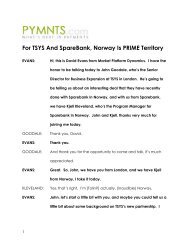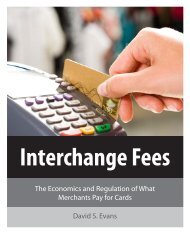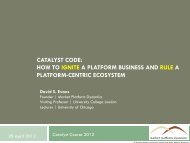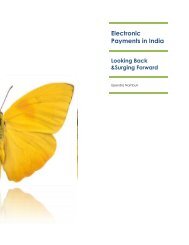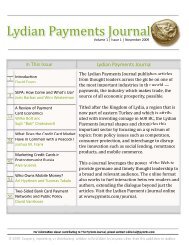Two-Sided Market - PYMNTS.com
Two-Sided Market - PYMNTS.com
Two-Sided Market - PYMNTS.com
You also want an ePaper? Increase the reach of your titles
YUMPU automatically turns print PDFs into web optimized ePapers that Google loves.
CHAPTER THIRTEEN<br />
11 TABLE OF CONTENTS<br />
Part Four<br />
The Effect of regulatory Intervention in <strong>Two</strong>-<strong>Sided</strong> <strong>Market</strong>s:<br />
An Assessment of Interchange-fee Capping in Australia<br />
Abstract:<br />
The Reserve Bank of Australia reduced interchange fees by almost half thereby eliminating a significant<br />
source of revenue to issuers of credit cards. The purpose of this intervention was to align the prices of<br />
using various payment instruments with their social costs and thus reduce the use of cards, which the RBA<br />
viewed as a socially less efficient payment method than cash, checks, and PIN debit cards. The shortrun<br />
result of this regulatory intervention has been the following: (1) Bank issuers have increased the fixed<br />
prices for cards and thereby recovered between 30 and 40 percent of the loss of interchange fee revenue;<br />
this fraction is likely to increase over time as cards renew and new solicitations go out. Bank issuers have<br />
not changed the per-transaction fees for cards much. (2) Merchants experienced a very small reduction<br />
in their costs. Both theory and limited empirical evidence suggest that the highly concentrated merchant<br />
sector in Australia has captured the reduction in interchange fees as profits and has not passed it on in<br />
the form of lower consumer prices. (3) The per-transaction price at the point of sale has not changed<br />
significantly. Merchants have not generally availed themselves of their right to surcharge card transactions<br />
and the per-transaction price faced by consumers from their card issuers has not changed much. Holding<br />
the number of cards fixed, the regulatory intervention has not altered prices in a way that could achieve<br />
the intent of the intervention. (4) There is relatively little evidence thus far that the intervention has in fact<br />
affected the volume of card transactions in Australia as intended by the regulation. (5) In the short-run, the<br />
effect of the regulation has been to transfer significant profits to the Australian merchant sector with that<br />
transfer being borne partly by bank issuers and partly by cardholders. (6) Since proprietary systems such<br />
as American Express were not subject to the pricing regulations and since American Express can enter into<br />
deals with banks to issue cards, banks have shifted volume from the regulated association systems to the<br />
unregulated proprietary systems.<br />
PAYMEnT CArdS



